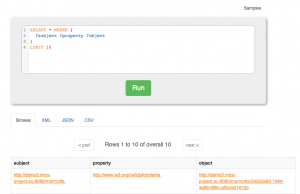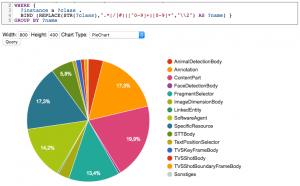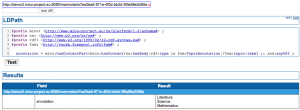To enable result querying in the Mico Platform we use the standard Marmotta query interfaces (that are partly an outcome of the Mico project). The User Interfaces are purely build on top of webservices, so the interfaces are accessible by both, human and machines. The query languages itself are exhaustively described within the Mico Technical Reports. In this section we give a short overview on the query interfaces.
SPARQL query interface
SPARQL is the de-facto standard query language and protocol for the Semantic Web. Marmotta integrates this standard and allows to issue queries by standardized webservices as well as via using a proper user interface. The Marmotta SPARQL UI is using the standalone Open Source project Squebi, which is a clean SPARQL UI supporting:
- customization of SPARQL result visualization
- support for SPARQL 1.1 (update and select)
- bookmarkable uris that define queries and the visualization type
- support for SPARQL query editing
- Auto-creation of URIs prefixes
- Autocompletion for well known ontologies

Marmotta SPARQL query UI (enabled by Squebi)
SGVizler data visualization
The Marmotta framework integrates the data visualization framework SGVizler that allows to turn SPARQL results into graph visualizations. Thereby it supports a broad set of visual types, like charts, maps, tables, etc.

SPARQL data result visualization with SGVizler
LDPath query interface
In addition to SPARQL, the Mico System (or the underlying Marmotta RDF Store) supports a Graph Traversal Language called LDPath. Starting from a resource, the whole data graph can be walked through. The user is rather simple but may be extended in further versions.

LDPath query interface